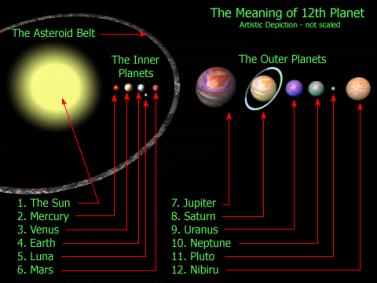  |
| Maya Calendar - End of the World - December 21, 2012 |
|
|
|
|
|
|
|
  |

NASA 2012 Calculations for a Big Disaster on Earth! Posted by: krisjohnco in Personal.- I have been receiving information and reading a lot of news and stories online regarding the possibility of having a BIG shift on earths events, possibility of slowing the earths rotation. Let me give you a bigger picture regarding these findings, Are you familiar with the so called “Planet X” or “Nibiru” ? They said that this big mass of accumulated elements or rocks could be another planet aside from the 9 planets we currently have, but recently declared we only have 8 planets in our solar system after they removed Pluto from there. Through the years they are studying the possibility of Planet X being a real planet, element and chemical content and alike. after undergoing massive research about this, they have found out that there is an enormous force in that Planet that could make affect the near by planets. The Planet X does the same pattern rotation for all of the planet circulating around the sun. How will this force affect the the Earth? there are a lot of speculations, articles, point of views that are coming out, that the earth will stop its rotation for 3 days, for some it will just decelerate and for some it will tilt by 90 degrees. Which is which? Below is a news from NASA
that shocked me a lot…
March 10, 2006: It’s official: Solar minimum has arrived. Sunspots have all but vanished. Solar flares are nonexistent. The sun is utterly quiet. Like the quiet before a storm.
That was a solar maximum. The Space Age was just beginning: Sputnik was launched in Oct. 1957 and Explorer 1 (the first US satellite) in Jan. 1958. In 1958 you couldn’t tell that a solar storm was underway by looking at the bars on your cell phone; cell phones didn’t exist. Even so, people knew something big was happening when Northern Lights were sighted three times in Mexico. A similar maximum now would be noticed by its effect on cell phones, GPS, weather satellites and many other modern technologies. Right: Intense auroras over
Fairbanks, Alaska, in 1958.
The key to the mystery, Dikpati realized years ago, is a conveyor belt on the sun. We have something similar here on Earth—the Great Ocean Conveyor Belt, popularized in the sci-fi movie The Day After Tomorrow. It is a network of currents that carry water and heat from ocean to ocean–see the diagram below. In the movie, the Conveyor Belt stopped and threw the world’s weather into chaos. The sun’s conveyor belt is a current, not of water, but of electrically-conducting gas. It flows in a loop from the sun’s equator to the poles and back again. Just as the Great Ocean Conveyor Belt controls weather on Earth, this solar conveyor belt controls weather on the sun. Specifically, it controls the sunspot cycle. Solar physicist David Hathaway of the National Space science & Technology Center (NSSTC) explains: “First, remember what sunspots are–tangled knots of magnetism generated by the sun’s inner dynamo. A typical sunspot exists for just a few weeks. Then it decays, leaving behind a ‘corpse’ of weak magnetic fields.” Enter the conveyor belt.
Right: The sun’s “great conveyor belt.” All this happens with massive slowness. “It takes about 40 years for the belt to complete one loop,” says Hathaway. The speed varies “anywhere from a 50-year pace (slow) to a 30-year pace (fast).” When the belt is turning “fast,” it means that lots of magnetic fields are being swept up, and that a future sunspot cycle is going to be intense. This is a basis for forecasting: “The belt was turning fast in 1986-1996,” says Hathaway. “Old magnetic fields swept up then should re-appear as big sunspots in 2010-2011.” Like most experts in the field, Hathaway has confidence in the conveyor belt model and agrees with Dikpati that the next solar maximum should be a doozy. But he disagrees with one point. Dikpati’s forecast puts Solar Max at 2012. Hathaway believes it will arrive sooner, in 2010 or 2011. “History shows that big sunspot cycles ‘ramp up’ faster than small ones,” he says. “I expect to see the first sunspots of the next cycle appear in late 2006 or 2007—and Solar Max to be underway by 2010 or 2011.” Who’s right? Time will tell. Either way, a storm is coming. Now, read the article? what do you think? here the add-on: “According to NASA scientists, the earth will stand still for about three days and then, in one hour, rotate a full 90 degrees (the geographical pole shift) during which time winds will be an average of 200 miles per hour. Every volcano on earth will erupt and of course there will be many earthquakes, so two thirds of earth’s population will die in that one hour surprise. Then another 20% will starve to death during the next six months because the volcanic ash will cover the earth and keep out sunlight for six months. About 10% of the [world’s] population (about 600 million) will survive. “NASA’s top scientists wanted to go to Mars and survive but that didn’t work out. So they are making a space station which will be able to maneuver itself on the other side of earth, using earth as a shield between the space station and Planet X. This way the top scientists will live. He said it is already affecting Neptune’s gravitational pole and once it gets close to Pluto, it will take only three months to get here. Once near Pluto it will be a “red dot in the sky” which will gradually get bigger during several months, and can be seen with the naked eye six weeks before the pole shift. The northern inland part of the States is good; it is where the scientists are going. This will be near the equator after the shift.” Now? what do you feel now? shocking isn’t it? Imaging this would happen, what do you think will happen to us? here are the possibilities, 1. Water will rise up as high as a mountain like Noah’s Arc event in the Bible. 2. Land will be covered by water. ( water will be moving to land and what is left by the water will be the new land) 3. Occurrence of Strong magnitude of Earth Quake. 4. Weather disturbance ( tornado and cyclones) 5. Death of almost 90% of earths Population. These are just some of the
many possibilities.. there might be more… what we could only do is to PRAY.
|
|
|
|
|
|
|
  |

Multi Dimensional Entertainment magazine from INDIA |
 |